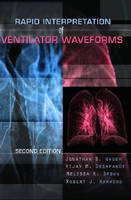
Rapid Interpretation of Ventilator Waveforms
Pearson (Verlag)
978-0-13-174922-1 (ISBN)
- Titel ist leider vergriffen;
keine Neuauflage - Artikel merken
CONTENTS
PREFACE vii
1. VENTILATOR GRAPHICS AND CLINICAL APPLICATIONS 1
I. Basic Concepts, 1
II. Effect of Setting Changes on Waveforms, 2
III. Effect of Flow Rate on Inspiratory and Expiratory Time, 4
IV. Effect of Resistance and Compliance Changes, 6
V. Scalars, 8
VI. Modes of Ventilation and Corresponding Scalars, 10
Control Mode Ventilation, 10
Assist Mode Ventilation, 13
Sychronized Intermittent Mandatory Ventilation
(SIMV), 15
SIMV with Pressure Support Ventilation (PSV), 17
SIMV with PSV and Continuous Positive Airway Pressure
(CPAP), 19
Pressure Control Ventilation (PCV), 21
2. PRESSURE-VOLUME AND FLOW-VOLUME LOOPS 23
I. Total Lung Compliance, 23
II. Pressure-Volume Loops, 27
III. Work-of-Breathing, 32
IV. Flow-Volume Loops, 34
V. Interpretation of Loops, 36
3. WAVEFORMS FOR COMMON VENTILATOR MODES 53
I. Volume-Targeted Scalars, 55
Volume-Targeted Control Ventilation, 55
Volume-Targeted Assist Control Ventilation, 55
Volume-Targeted SIMV, 55
II. Pressure-Targeted Scalars, 57
Pressure-Targeted Control Ventilation, 57
Pressure-Targeted Assist Control Ventilation, 57
Pressure-Targeted SIMV, 57
III. Spontaneous Scalars, 59
Continuous Positive Airway Pressure (CPAP), 59
Pressure Support Ventilation (PSV), 59
PSV with CPAP, 59
Setting Rise Time for PSV, 60
Bilevel and APRV, 61
iii
table of contents rev.qxd 4/12/06 2:24 PM Page 1
IV. Combination Modes: Volume-Targeted Scalars, 63
Volume-Targeted SIMV with CPAP, 63
Volume-Targeted SIMV with PSV, 63
Volume-Targeted SIMV with PSV and CPAP, 63
V. Combination Modes: Pressure-Targeted Scalars, 65
Pressure-Targeted SIMV with CPAP, 65
Pressure-Targeted SIMV with PSV, 65
Pressure-Targeted SIMV with PSV and CPAP, 65
VI. Volume-Targeted Pressure-Volume (P-V) and
Flow-Volume (F-V) Loops, 67
Volume-Targeted Controlled Ventilation with a
Constant Flow, 67
Volume-Targeted Assisted Ventilation with a
Constant Flow, 67
Volume-Targeted SIMV, 67
VII. Pressure-Targeted P-V and F-V Loops, 69
Pressure-Targeted Controlled Ventilation, 69
Pressure-Targeted Assisted Ventilation, 69
Pressure-Targeted SIMV, 69
VIII. Spontaneous Ventilation P-V and F-V Loops, 71
CPAP, 71
PSV, 71
PSV with CPAP, 71
IX. Combination Modes: Volume-Targeted P-V and F-V Loops, 73
Volume-Targeted SIMV with CPAP, 73
Volume-Targeted SIMV with PSV, 73
Volume-Targeted SIMV with PSV and CPAP, 73
X. Combination Modes: Pressure-Targeted P-V and F-V Loops, 75
Pressure-Targeted SIMV with CPAP, 75
Pressure-Targeted SIMV with PSV, 75
Pressure-Targeted SIMV with PSV and CPAP, 75
4. MONITORING PRESSURE AND VOLUME VENTILATION 77
I. Volume vs. Pressure Ventilation Scalars, 78
II. Inspiratory Pause During Volume and Pressure Ventilation, 79
III. Effects on Increased Airways Resistance on Volume- and Pressure-
Targeted Ventilation, 81
IV. Effects of Decreased Compliance, 84
V. Three conditions for Pressure-Targeted Breaths, 85
VI. Descending Ramp Flow in Pressure Control, Pressure Supported,
and Volume-Targeted Breaths, 85
iv CONTENTS
table of contents rev.qxd 4/12/06 2:24 PM Page 2
5. COMMON CLINICAL FINDINGS 86
I. Changes in Respiratory System Compliance, 87
Decreased Compliance and Inflection Points, 87
Overdistension, 90
Active Exhalation, 91
II. Airway Obstruction, 92
Bronchospasm: Bronchodilator Benefit Assessment, 92
Air-trapping from Dynamic Hyperinflation, 94
Air-trapping from Early Small Airway Collapse, 96
Kinked Endotracheal Tube, 98
III. Patient-Ventilator Dyssynchrony, 99
Inadequate Inspiratory Flow Rate, 99
Inappropriate Trigger Sensitivity, 100
Patient and Ventilator Rates Out of Synchrony, 102
IV. Leaks, 103
6. NEONATAL APPLICATIONS 104
I. Introduction, 105
II. Normal Infant Pulmonary Functions, 106
III. Normal Scalars, Flow-Volume (F-V), and Pressure-Volume (P-V)
Loops, 107
IV. Abnormal Waveforms, 114
Improper Sensitivity Scalars, 114
Large Air Leak and Autocycling Scalars, 115
A/C Pressure Control Asychrony Scalars, 116
A/C Pressure Control F-V and P-V Loops, 117
Inadequate Flow Scalars, 118
Inadequate Rise Time or Flow, 118
Excessive Inspiratory Pressure and Flow Scalars, 119
Effect of Excessive Inspiratory Pressure on the
P-V Loop,119
Reduced Compliance F-V and P-V Loops, 120
Excessive Inspiratory Time Scalars, 121
Inspiratory Flow Termination Scalars, 122
Termination of Inspiratory Flow, 122
Breath-Stacking (Auto-PEEP) Scalars, 123
Breath-Stacking F-V and P-V Loops, 124
Obstruction to Expiratory Flow Scalars, 125
Obstruction to Expiratory F-V and P-V Loops, 126
Right Mainstem Intubation Scalars, 127
CONTENTS v
table of contents rev.qxd 4/12/06 2:24 PM Page 3
Right Mainstem Intubation F-V and P-V Loops, 128
Progression to Extubation Scalars, 129
Turbulent Baseline Flow Rate Scalars, 130
High Frequency Ventilation, 131
Appendix A: CASE STUDIES 134
Appendix A: VENT WAVEFORMS CHECKLIST 144
BIBLIOGRAPHY 145
INDEX 147
| Erscheint lt. Verlag | 2.11.2006 |
|---|---|
| Sprache | englisch |
| Maße | 152 x 229 mm |
| Gewicht | 236 g |
| Themenwelt | Medizin / Pharmazie ► Medizinische Fachgebiete ► Pharmakologie / Pharmakotherapie |
| Wirtschaft | |
| ISBN-10 | 0-13-174922-6 / 0131749226 |
| ISBN-13 | 978-0-13-174922-1 / 9780131749221 |
| Zustand | Neuware |
| Haben Sie eine Frage zum Produkt? |
aus dem Bereich


